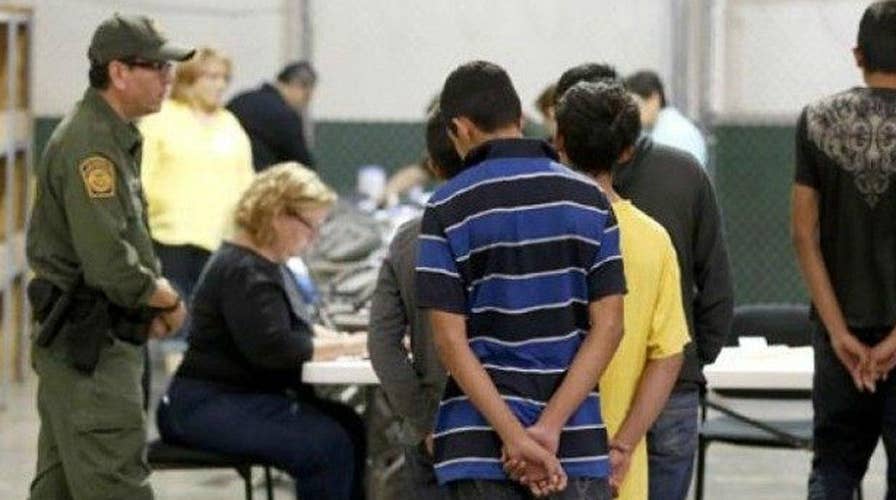Will crackdown on illegal immigrants curb crime?
House votes on defunding sanctuary cities bill and Kate's Law; reaction on 'The Fox News Specialists'
The House of Representatives recently passed two laws to crack down on illegal immigrants in the United States – Kate’s Law (H.R. 3004) and the No Sanctuary for Criminals Act (H.R. 3003). Both were prompted by the tragic 2015 murder of Kate Steinle by an illegal immigrant named Juan Francisco Lopez-Sanchez, and by the perception that illegal immigrants have created a crime wave.
That perception is simply untrue.
Illegal immigrants are not all criminals, as most immigration offenses are civil violations and not criminal ones. Civil violations in immigration law are punished with deportation, while criminal violations are punished with jail time. The Center for Migration Studies estimates that 66 percent of illegal immigrants who entered in 2014 did so by overstaying a visa, which is not a crime. It’s difficult to prove in court that the other 36 percent committed a crime by entering illegally.
Fear of an illegal immigrant crime wave is sparked by the fear that they are overwhelmingly murderers, rapists, and thieves. In reality, illegal immigrants have lower incarceration rates and live in places with lower crimes rates than native-born Americans.
Regardless, fear of an illegal immigrant crime wave is not sparked by the specter of people breaking administrative immigration rules, but by fear that they are overwhelmingly murderers, rapists, and thieves. In reality, illegal immigrants have lower incarceration rates and live in places with lower crimes rates than native-born Americans. Far from perpetrating a crime wave, immigrants actually decrease crime rates.
Those who think illegal immigrants are unusually crime-prone tend to make several errors when making their case. The most common is to only look at non-citizen incarcerations in federal prisons. First, that is a bad measurement because non-citizens includes illegal immigrants and also legal non-citizens, so it is an over count. Second, federal prisons only hold about 10 percent of all prisoners, with the other 90 percent incarcerated in state and local prisons and jails.
Federal prisons hold prisoners convicted of federal crimes or crimes committed while crossing a border, including immigration offenses and drug smuggling, which disproportionately lead to foreigners being imprisoned. In May 2017, the last month for which data are available, 46.3 percent of federal inmates were incarcerated for drug offenses and 8.2 percent for immigration crimes. Imprisonment of non-violent drug and immigration offenders is not the hallmark of a crime wave.
Looking at all incarcerated prisoners in state, federal, and local adult correctional facilities provides a more accurate picture of illegal immigrant criminality. Based on census data, the numbers show that illegal immigrants are about 44 percent less likely to be incarcerated than native-born Americans. Focusing on prisoners between the ages of 18 and 54, 1.53 percent of all native-born adults are incarcerated, compared with 0.85 percent of illegal immigrants in the same age range – including those incarcerated for immigration crimes and in immigration detention. Excluding those particular crimes brings the illegal immigrant incarceration rate down to 0.50 percent – one third of the native rate.
This holds true even when you take race into account. Whereas white, native-born Americans are incarcerated at a rate of 0.90 percent, illegal immigrants of every race and ethnicity are still less likely to be incarcerated, at a rate of 0.85 percent.
American cities with more illegal immigrants do not have higher crime rates. Even immigration restrictionists like Representative Steve King, R-Iowa, admit that legal immigrants are less crime-prone than natives, but they also live in the same cities as illegal immigrants. This makes it difficult to estimate how illegals affect crime rates on the local level.
However, the evidence strongly suggests that they at least don’t worsen them. A study of recidivism rates in Los Angeles conducted by two RAND Corporation scholars discovered that there was no difference between rearrest rates over a 30-day period between illegal and legal immigrants. While not perfect, this study is still broadly consistent with the others.
Federal and state governments do not consistently record the number of incarcerated illegal immigrants – they should start doing so immediately. Regardless, the available evidence overwhelmingly shows that illegal immigrants are incarcerated at lower rates than native-born Americans. As for the supposed illegal immigrant crime-wave, the evidence for that remains to be seen.





















